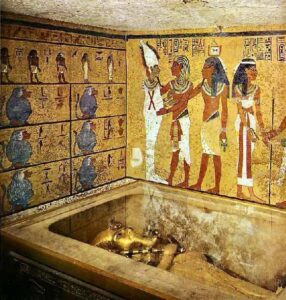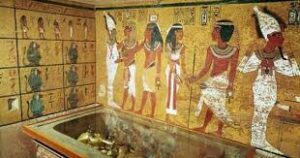I. Introduction to the Tomb of Pharaoh Tutankhamun
The tomb of Tutankhamun, a young pharaoh of Egypt’s 18th Dynasty, was discovered in 1922 in the Valley of the Kings. Unearthed by British archaeologist Howard Carter, this tomb is one of the few that remains largely intact, containing countless treasures, valuable artifacts, and insights into the funerary practices of ancient Egypt. Tutankhamun ruled Egypt from approximately 1332 to 1323 BC, and his tomb has opened a window into the life and beliefs of ancient Egyptians.

II. Design and Structure of the Tomb
Tutankhamun’s tomb, while smaller in scale compared to many other royal tombs, is still a marvel of ancient architecture. It consists of a series of rooms arranged simply, including a burial chamber that houses the pharaoh’s body in a lavishly decorated sarcophagus. Other chambers contain numerous artifacts, such as chariots, furniture, personal items, and offerings intended for the afterlife.

III. The Treasures Within the Tomb
A. The Golden Sarcophagus and Death Mask
At the center of the tomb lies the golden sarcophagus containing Tutankhamun’s mummified body, intricately crafted and adorned with elaborate decorations and symbols of power. Inside the sarcophagus rests the iconic golden death mask, made of solid gold and inlaid with precious stones like lapis lazuli and carnelian. The death mask symbolizes the pharaoh’s divine status and serves as a sacred protector, ensuring his immortality in the afterlife.
B. Funerary Objects for the Afterlife
Surrounding the sarcophagus are a wealth of items meant to assist Tutankhamun in his journey to the afterlife, including gilded shrines, alabaster canopic jars for holding his internal organs, and various personal belongings. The ancient Egyptians believed these items would sustain the pharaoh in the next life. Each artifact is rich in symbolism, reflecting the beliefs about immortality and the life beyond.
IV. Wall Paintings: The Journey to the Afterlife
The walls of the tomb are adorned with vivid, well-preserved paintings depicting Tutankhamun’s journey into the afterlife. These images portray deities, protective symbols, and ritual scenes, illustrating the pharaoh’s transcendence and the guidance necessary for his soul to navigate the realm beyond. These artworks are not only valuable from an artistic perspective but also provide insight into ancient beliefs about death and the afterlife.

V. The Significance of Discovering Tutankhamun’s Tomb for History and Culture
Howard Carter’s discovery was not only a historical milestone but also provided profound insights into ancient Egyptian culture, religious practices, and artistry. The treasures of the tomb, largely untouched by looters, offer a rare glimpse into royal burial customs and have reshaped our understanding of ancient rituals, making Tutankhamun one of history’s most studied figures and a lasting symbol of ancient Egyptian civilization.
VI. Global Impact and Fascination with the “Boy King”
The discovery of Tutankhamun’s tomb sent shockwaves through the archaeological community and ignited a global fascination. The artifacts have traveled the world in exhibitions, generating immense public interest and creating an “Egyptomania.” As a result, Tutankhamun’s image has become a cultural icon, inspiring art, literature, and film, and captivating the modern world with the mysteries of ancient Egypt.
VII. Conclusion
The tomb of Tutankhamun, with its rich collection of artifacts and cultural significance, stands as one of the greatest archaeological discoveries of the 20th century. Through this tomb, we gain a tangible glimpse into royal life and the beliefs of ancient Egyptians, while also experiencing the power of history to connect modern humans with the past. This discovery represents a remarkable journey into the ancient world and serves as a living testament to the enduring legacy of cultural heritage.
